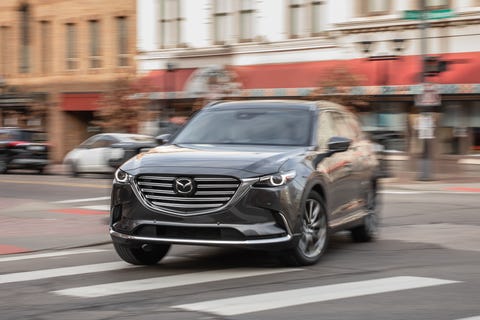
Michael SimariCar and Driver
The current-generation Mazda CX-9 may have debuted for the 2016 model year, but it still cuts a dashing figure both inside and out, and it remains the driver’s choice in the mid-size three-row SUV segment. We’ll always have a soft spot for it. A handful of improvements for 2020, including under the hood, make us like the big Mazda even more, although they do little to address its shortcomings in a segment flush with newer competition.
The most significant change for the latest CX-9 is an additional 10 lb-ft of torque from its 250-hp turbocharged 2.5-liter inline-four. Running on premium fuel, the engine now sends 320 lb-ft of torque to the wheels via the standard six-speed automatic transmission. Feed the Mazda regular, however, and those figures drop to 227 horses and 310 lb-ft. All-wheel drive remains a $1900 option on most trim levels except the top-spec Signature, which is all-wheel-drive only.
Performance Gains
Compared to the last CX-9 we tested, a 2019 Signature model that finished behind the Hyundai Palisade and Kia Telluride in a comparison test of mid-size three-row utes, a similar 2020 model weighed roughly the same (4364 pounds) yet was measurably quicker in a straight line. Its zero-to-60-mph run in 7.0 seconds is an improvement of 0.2 second, and its 15.4-second quarter-mile pass at 90 mph is a similar amount quicker and 2 mph faster than before. The delta in acceleration times stretches to nearly two seconds in the race to 120 mph.
This Mazda’s extra poke comes mostly at low engine speeds, though it is difficult to notice in normal driving. The thrust from the CX-9’s big four is entirely adequate, but the engine still runs out of steam by about 5000 rpm. Passing maneuvers at highway speeds can feel labored. Our test vehicle’s 4.9-second pull from 50 to 70 mph is but a tenth of a second quicker than before. Even with the additional low-end punch, some of the CX-9’s peers can be roughly a second quicker to 60 mph.
The six-speed automatic remains nicely tuned to shift smoothly and effectively in its default setting and is surprisingly aggressive in Sport mode. However, we did notice a few low-speed clunks as the gearbox downshifted when pulling up to stops. We averaged a so-so 20 mpg during our two weeks with the CX-9. Its 25-mpg return on our 75-mph highway fuel-economy test, while 1 mpg less than its EPA highway estimate, is respectable for this class.
Nothing has changed with the CX-9’s chassis, which means the three-row Mazda still bobs and weaves down twisty back roads with the control and confidence of a much smaller vehicle. Its electrically assisted steering remains tight and precise, and its brake pedal is reassuringly firm and easy to modulate. Rolling on standard 20-inch Bridgestone Ecopia H/L 422 Plus all-season tires, our test vehicle posted 0.85 g’s of grip around the skidpad and a 169-foot stop from 70 mph, both of which would have been tops in our most recent comparison test.
Inviting yet Aging
Unfortunately, not much has changed with the CX-9’s rather tight packaging for a three-row SUV, save for the addition of newly available second-row captain’s chairs. They’re optional on the mid-grade Touring and Grand Touring trim levels and standard on the Signature. A conventional three-across bench seat remains standard otherwise. Regardless of which configuration you choose, crawling into the way back is still an effort, the available space back there for adult humans is cramped, and cargo space behind the third row is tiny.
The trappings of this Mazda, particularly those of the top-level Signature model like our test vehicle, remain highly attractive and beautifully finished. Hyundai and Kia are closing the gap in this regard, though, and both the Palisade and Telluride are more capacious for people and stuff. The upgrading of the CX-9’s largest available infotainment touchscreen from 8.0 to 9.0 inches (a 7.0-incher remains standard) somewhat brightens the cabin. Yet, it’s still a stretch to reach from the driver’s seat, and the redundant scrolling wheel on the center console is a clumsy tool for navigating Mazda’s slow and dated interface. The integration of Mazda’s latest system, as seen in the Mazda 3 and new CX-30 compact SUV, would have been a more welcome addition than the bigger screen.
Pricing for the front-drive 2020 Mazda CX-9 Sport starts at $34,835. Our loaded Signature AWD test vehicle was a reasonable $47,560. But here, too, the CX-9’s value proposition has been diminished, as both of its newer Korean competitors top out at similar price points but bring greater practicality and feature content. We’ll always enjoy driving the big Mazda. But living with it as the utility vehicle it was designed as, even with its most recent updates, is not as satisfying as it once was.
Source: Reviews - aranddriver.com




